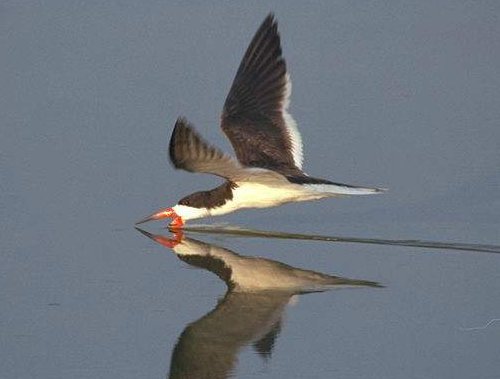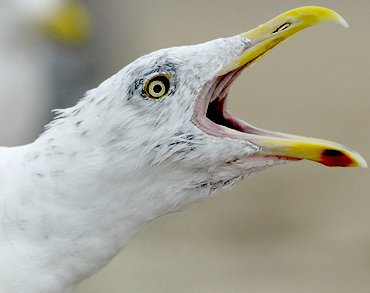Sea Gulls
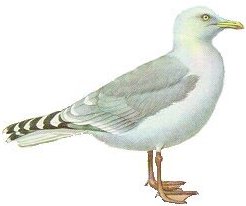
Sea Gulls are found from the oceans to the Great Plains to any parking lot.
Herring Gulls Larus argentatus (right) are large, raucous, and sometimes aggressive. They grow to 20", with a wingspan of up to 55". These birds quickly learn to accept handouts and will attack small children on the beach to steal food from them. Discourage this behavior by never feeding them. Immature specimens are as large as adults, but dirty brown.
Gulls are typically scavengers, feeding upon whatever carrion and flotsam they can find. They are also not above stealing food from other birds. Jaegers are sea birds that specialize in stealing food from gulls!
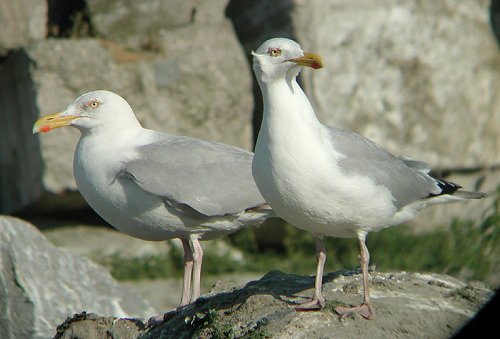
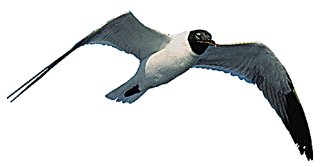
Laughing Gulls Larus atricilla are smaller, tern-like, with a black head and a laughing call. This is a common summer gull along the Atlantic and Gulf coasts, but its numbers have dropped in recent years because much of its coastal marsh habitat has been destroyed, and because Herring Gulls prey on its eggs and young. Laughing Gulls are very agile flyers and easily catch bits of food tossed into the air.
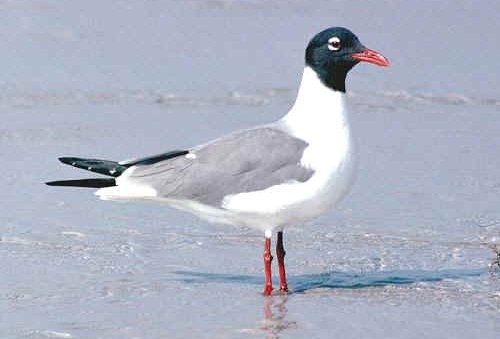
A CLOSER LOOK AT NEW JERSEY'S GULLS
BY WADE WANDER AND SHARON ANN BRADY
photos by the authors
Although the 1975 appearance of the rare Ross Gull lured thousands of birders to Massachusetts and catapulted gulls into temporary national prominence, these abundant and boisterous birds still go largely unnoticed. Living in a coastal state, most New Jerseyans are well aware that we have a more than ample population of 'seagulls': but most people are not aware of the variety of species. plumages, behaviors, and habitats that make gulls one of our most fascinating groups of birds:
To begin with, the name 'seagull' is really misleading, for all New Jersey species but one are birds of the coast and estuaries rather than of the open sea. In fact, unless there is a fishing fleet operating in the area, gulls are almost totally absent out of sight of land. Actually, many species of gulls are quite common inland. Several species, such as Franklin's Gull, even breed in the interior of North America. Another, the California Gull, is, oddly enough, the state bird of Utah ( because a hungry flock saved early Mormon settlers from an equally hungry plague of locusts ! ) In New Jersey, gulls can be found inland anywhere, anytime. but are most often seen making their daily rounds from the coast to reservoirs and lakes, or in plowed fields eating insects.
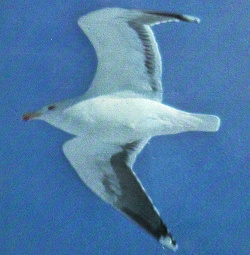 Great Black-backed Gull - Adult From below this species is easily identified by its robust body; long, heavy wings; and extensive black on underwings. | 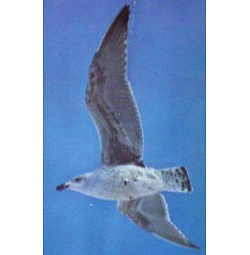 Great Black-backed Gull - Immature First-year birds such as this are similar to immature Herring Gulls but much lighter on the head, neck, the base of the tail, and underparts. |
'Seagull' is misleading in another way by its common usage to denote all gulls, regardless of species. This is unfortunate, as even a casual New Jersey observer can expect to find five species of gulls - Herring, Ring-billed, Laughing, Great Blackbacked, and Bonaparte's - while a truly diligent birder may turn up six more - Iceland, Black-headed, Glaucous, Little, Lesser Blackbacked, and Black-legged Kittiwake.
Though they differ in many ways, all 11 species do exhibit 'delayed maturity'; depending on its species, an individual bird, although the size of an adult, takes from two to four years to reach sexual maturity and the accompanying adult plumage. During this time, juvenile gulls display an endless variety of intermediate plumages - so much so that you'll hardly ever see two identical immature gulls. Even the adults of most species will alternate summer and winter plumages - so it's quite a challenge to be able to accurately identify every species in any plumage! All the standard field guides, such as Peterson's A Field Guide to the Birds, Robbins', et al. Birds of North America, and Pough's Audubon Water Bird Guide, illustrate species and plumages not pictured here and provide more detailed information on gull identification.
Of the common species, the Herring Gull is the Starling of the gull world. Although they are numerous enough along our shoreline, the best place to see really astounding numbers of Herring Gulls is in garbage dumps, where their ecological role as opportunists and scavengers has enabled them to be one of the few species to benefit from man's waste-disposal methods. Although the Herring Gull is increasing as a breeder in New Jersey, like most other gull species found here it is much more common in winter.
New Jersey's most ubiquitous gull - and the one most commonly seen inland - is the Ring-billed, a denizen of every location from plowed fields to parking lots, golf courses to country lakes. The Ring-billed Gull does not breed in the state but is nevertheless quite common here during the summer because there are two or three years' worth of immature birds just loafing around until they grow up.
The Laughing Gull, on the other hand, does breed here - in several immense colonies in our southern salt marshes. Throughout the summer its raucous 'laugh' is one of the most familiar sounds all along the seashore. The Laughing Gull is unique among New Jersey Gulls in that it leaves for a Florida vacation in late fall and is unusual here in winter.
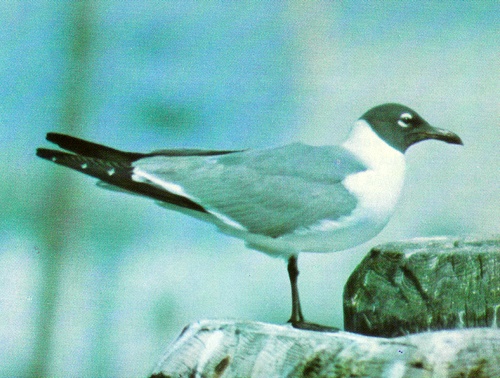
Laughing Gull - Adult
Unmistakable in summer with its dark red bill, broken white eye-ring, black head, and dark gray mantle. Winter adults ( seldom seen here ) lose the black headdress, retaining only a grayish cap across the back of the head.
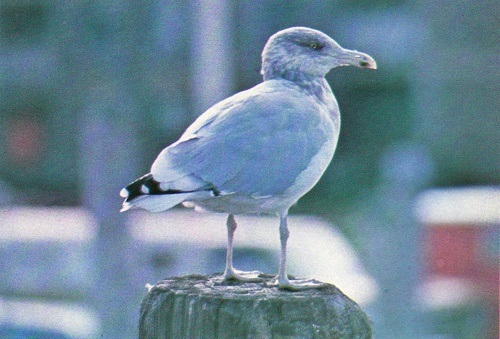
Herring Gull - Adult
A large gull with medium-gray back and upper wing surface (mantle), black wingtips, pink legs. In summer the head and breast are pure white; winter birds, such as this one, display a mottled brownish
Our largest and most impressive gull, the Great Black-backed, is rapidly expanding its range southward and has recently begun breeding in New Jersey. Like the Herring Gull, the Great Black-backed is a bird of the garbage dumps and seashore, where it dominates other gulls by virtue of its large size and aggressive behavior. It is our most predatory gull, frequently raiding nesting colonies of other seabirds and occasionally killing rats and even birds as large as Black Ducks.
Bonaparte's Gull, in contrast, is among our smallest gulls, light and graceful on the wing. The best time to observe it is in winter when you'll find flocks of up to a thousand or more Bonaparte's Gulls along the coast. When migrating to and from its breeding colonies, this species may sometimes be seen briefly on our larger inland lakes. Interestingly, the Bonaparte's Gull uses a nesting site unique among gulls, most species of which are ground-nesters; the birds you see here were fledged from nests in spruce or fir trees in northwest Canada!
Among the six rarer species, the Iceland and Glaucous gulls ( informally called 'white-winged' gulls because of the absence of black in their primary flight feathers ) are winter visitors from the far north. In New Jersey, immature rather than adult birds are most often seen, usually at garbage dumps in the company of Herring Gulls. A day's birding in the Hackensack Meadowlands might produce up to half a dozen Icelands and maybe one Glaucous - out of 10,000 Herring Gulls!
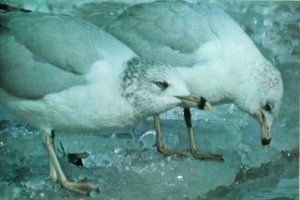 Ring-billed Gull - Adult Looking like a smaller version of the Herring Gull, this species differs by having yellow legs and a black ring on a yellow bill. 'Winter hoods' are visible on these birds; the head is white in summer | 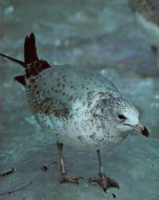 Ring-billed Gull - Immature Marked by its black-tipped pink bill ( no ring ), brown splotches on a gray mantle and upper breast. |
The Bonaparte-like Black-headed and Little gulls are rare but regular winter visitors from Europe! They are not 'dump birds, ' but do display equally unsavory tastes in their preference for sewer outlets in Raritan and New York bays.
The Black-legged Kittiwake is our one gull that is unusual within sight of land - although it occurs in flocks of thousands well offshore in winter. During strong easterly winds, however, it might be seen in small numbers from any location along the Jersey coast.
Although a really skillful birder might spot something like a Franklin's Gull, or with some real luck even a Yellow-legged Herring Gull, the rarest of New Jersey's 'regular' gulls he's likely to see is undoubtedly the Lesser Black-backed Gull. One or two individuals of this European species, a smaller version of our Great Black-backed, are reported every winter in our area.
Despite the many species and their varied plumages, perhaps the most fascinating aspect of gulls is their behavior. Even an assemblage of resting gulls is constantly active with comings and goings, squabbles and preenings. Usually, however, gulls are preoccupied with feeding; perhaps, as Henry Beston empathized in The Outermost House, they can never do more than 'dull the edge of their hunger.' So gulls are past masters at scrounging a meal, whether by begging scraps from homebound fishing boats. blitzing incoming garbage trucks, or shattering clams with a 'bombs away' over rock or road. Although a gull locating a promising food source may perform distinctive aerial maneuvers to inform other gulls of his discovery, the pandemonium of feeding, fighting, and food stealing that soon erupts, with its cacophony of piteous and outraged screeching, would convince anyone that each and every gull lives indeed at the edge of starvation.
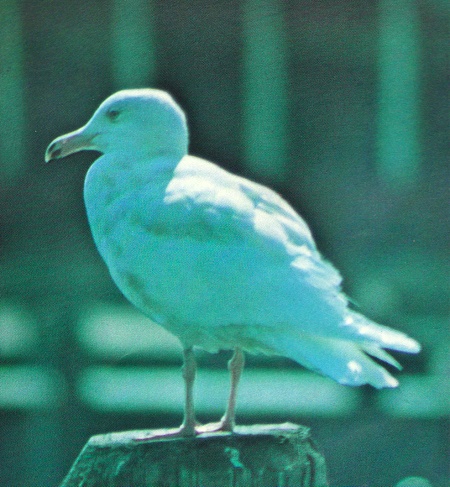
Glaucous Gull - Immature
Larger than a Herring Gull. The nearly snow-white plumage of this second-year bird is in striking contrast to the grays and browns of most other gulls. First-year birds are very pale, mottled brown. Adults acquire a pale gray mantle but retain the white wingtips. Plumages of the smaller Iceland Gull are similar.
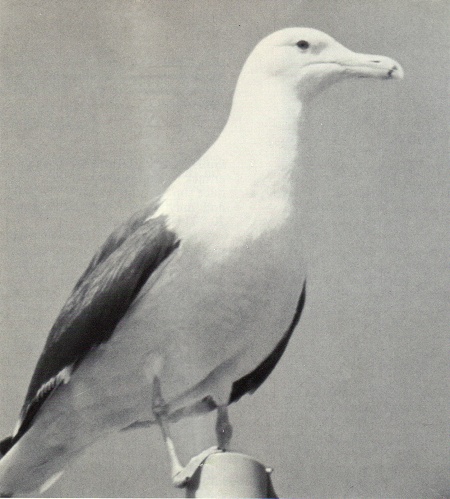
Great Black-backed Gull - Adult
Its large size and black wings and mantle contrasting with snow-white head, tail, and underparts make this lordly bird our easiest gull to identify. Plumage is the same in winter.
Studies of gulls' intriguing repertoire of displays and calls were among the important early contributions to the development of ethology ( the study of 'natural' animal behavior ), and scientists such as Dr. Joanna Burger of Rutgers University continue to study new aspects of gull behavior today.
So the next time you see a flock of 'seagulls, ' stop, take a closer look, and enjoy the varied appearances and behavior of these fascinating birds. We're sure you'll find in them an unexpected beauty and an interesting array of personalities.
Here is a list of some of our favorite locations to observe gulls:
- Hackensack Meadowlands - For sheer numbers of Herring and Great Black-backed gulls. Also the area with greatest numbers of 'white-winged' gulls.
- Liberty Park - Its location on New York Bay makes this park a good place for Black-headed and Little gulls.
- Raritan Bayshore - Particularly in the vicinity of South Amboy in late May or early June, this is the best area to see Black-headed and Little gulls. Hundreds of Bonaparte's winter here.
- Sandy Hook - Great Black-backed and Herring gulls are predominant here. Good for Laughing Gulls in summer and Bonaparte's in winter. White-winged gulls may occasionally be seen.
- Shark River and Manasquan River - Just about any species is possible at either estuary - both sport a history of rarities. At the docks along Channel Drive in Point Pleasant Beach the gulls are exceptionally approachable - good for close-up looks and photographs.
- Island Beach State Park and Barnegat Inlet - Another area where it is wise to be alert for anything, but especially good for Bonaparte's Gulls and Kittiwakes.
- Delaware Bayshore ( especially Reed's and Moore's beaches ) - One of the most spectacular sights in New Jersey birding is the tremendous concentration of Laughing Gulls here in May and June.
This article first appeared in New Jersey Outdoors - July / August 1977
